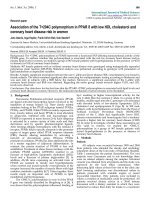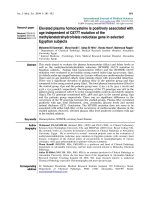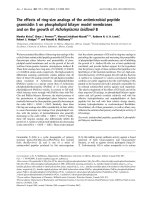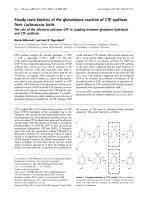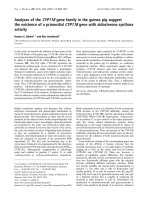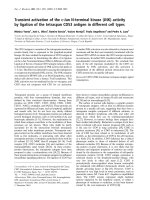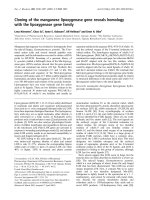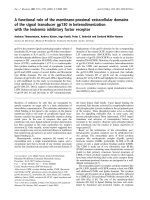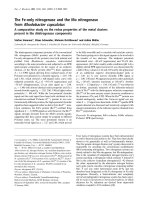Báo cáo y học: "Association of the T+294C polymorphism in PPAR δ with low HDL cholesterol and coronary heart disease risk in women"
Bạn đang xem bản rút gọn của tài liệu. Xem và tải ngay bản đầy đủ của tài liệu tại đây (183.2 KB, 4 trang )
Int. J. Med. Sci. 2006, 3
108
International Journal of Medical Sciences
ISSN 1449-1907 www.medsci.org 2006 3(3):108-111
©2006 Ivyspring International Publisher. All rights reserved
Research paper
Association of the T+294C polymorphism in PPAR δ with low HDL cholesterol and
coronary heart disease risk in women
Jens Aberle, Inga Hopfer, Frank Ulrich Beil, Udo Seedorf
Zentrum für Innere Medizin, Universitätsklinikum Hamburg-Eppendorf, Martinistr. 52, 20246 Hamburg, Germany
Corresponding address: Jens Aberle, e-mail: , Tel.: 0049 40 42803 4449 Fax: 0049 40 42803 8290
Received: 2006.02.28; Accepted: 2006.06.11; Published: 2006.06.13
Background: The +T294C polymorphism in PPARδ represents a functional SNP affecting transcriptional activity of the
PPARδ gene. To address whether this polymorphism is associated with the risk for coronary heart disease and/or
plasma lipid levels in women, we studied a group of 967 female patients with hyperlipidaemia in the presence (n=453)
or absence (n=514) of coronary heart disease.
Methods: 967 female patients with or without coronary heart disease were genotyped using mutagenically separated
polymerase chain reaction (MS-PCR). Statistical analysis was performed according to genotype with parameters of
lipid metabolism as dependant variables.
Results: A highly significant association between the rare C allele and lower plasma HDL concentrations was found in
female subjects. The effect remained significant after correcting for multiparametric testing according to Bonferoni and
was seen only in subjects with a BMI below the median. Moreover, a significant association of the C-allele with
coronary heart disease and BMI was obtained. Regarding the entire group, trends towards higher VLDL and LDL
levels were observed.
Conclusions: Our data show for the first time that the PPARδ +T294C polymorphism is associated with lipid levels and
coronary heart disease in women. However, the molecular mechanism of action remains to be elucidated.
1. Background
Peroxisome Proliferator-activated receptors (PPAR)
are ligand activated transcription factors involved in the
regulation of energy balance [1]. Three closely related
members belong to the PPAR subgroup termed PPARα,
PPARγ, and PPARδ. While PPARα is mainly expressed in
liver, muscle, kidney and heart, PPARγ is most abundant
in adipocytes, intestinal cells and macrophages and
PPARδ is expressed in many tissues [2-4]. Each subgroup
is activated by a certain variety of fatty acids and their
derivatives and by specific pharmacological ligands.
After forming obligate heterodimers with the retinoid X
receptor, PPARs bind to specific elements in the promoter
region of target genes called PPAR response elements
(PRE), thereby altering metabolism by activating a
network of downstream genes. Whereas PPARα
promotes ß-oxidation, PPARγ has been attributed the role
of a master regulator of adipocyte differentiation. In
contrast, the precise function of PPARδ is less well
established. Treatment of obese rhesus monkeys with the
synthetic PPARδ agonist GW501516 resulted in an
increase of high-density lipoprotein cholesterol (HDL)
levels and a decrease of plasma triglycerides [5]. In
addition, db/db mice expressing an activated form of
PPARδ are resistant to obesity and hyperlipidaemia
when overfed and muscle-specific overexpression of the
receptor increased the number of muscle fibers with high
oxidative metabolic capability [6,7]. Taken together, these
results imply an important role of PPARδ in lipid
metabolism and thermogenesis.
The +294T/C polymorphism in exon 4 of the PPAR
δ gene was initially described by Skogsberg et al [8]. It
was shown that the polymorphism influenced binding of
Sp-1 resulting in higher transcriptional activity for the
rare C allele than the common T allele. In a group of 543
healthy, middle-aged men the C genotype was associated
with elevated levels of low-density lipoprotein (LDL)
cholesterol and apolipoprotein B (Apo B). In 580 male
subjects with hyperlipidaemia recruited from the West of
Scotland Coronary Prevention Study (WOSCOPS)
carriers of the C allele had significantly lower HDL
plasma concentrations and homozygotes had a tendency
towards a higher risk for coronary heart disease (CHD)
[9]. In order to investigate whether these associations are
also valid in women, we studied the +294T/C
polymorphism in a group of 967 female patients with
mixed hyperlipidaemia in the presence or absence of
coronary heart disease.
2. Methods
Patients
All subjects were recruited between 1999 and 2004
from patients who attended the obesity and cardiology
outpatient clinics of the University of Hamburg Hospital.
Table 1 summarizes the patient characteristics. The vast
majority were Caucasians and to our knowledge there
were no related subjects among the samples. Informed
consent was obtained from all patients and the study was
approved by the local ethics commission. After
measuring lipid values at their first visit to the clinic any
lipid lowering medication was discontinued unless in
patients presented with unstable angina or recent
myocardial infarction. Only patients were included in
whom a cessation of medication could be performed. All
patients received dietary advice in a 30-60 minute
discussion with a dietary assistant in which they were
instructed to reduce their daily fat intake to a maximum
Int. J. Med. Sci. 2006, 3
109
of 40-55 g. Patient compliance was supervised by handing
out a nutritional diary which was submitted at each of
the further visits to the clinic. After 6 weeks the patients
attended the clinic again and it is the lipid values and
biometric data obtained at this visit which were used for
statistical analysis in this study. The presence of chd was
assessed by medical records and/or self-reported
questionnaire and each case was validated by cardiac
ultrasound and/or electrocardiographic examinations or
by coronary angiography.
Table 1: Patient characteristics.
CHD- CHD+ p-value
n 514 453
Age (years) 42.2 44.1
BMI (kg/m²) 25.9±6 28.8±7.4 0.01
Cholesterol (mg/dl) 269.6±65.7 285.3±131.3 ns
LDL 172.9±59.1 195.2±76.3 0.02
HDL 56.5±18.4 43.7±12 <0.001
VLDL 28.5±14.2 29.3±15.3 0.015
Triglycerides (mg/dl) 220.8±119.9 237.9±112 0.001
Apo B (mg/dl) 131.7±28.2 189±29.9 0.005
Apo A1 (mg/dl) 162.8±5.8 128±34.1 0.03
Lp(a) (mg/dl) 24.1±8.7 37.4±9.6 ns
Biochemical measurements
Plasma total cholesterol and triglycerides were
determined using GPO-PAP and CHOD-PAP kits,
respectively, from Boehringer Mannheim (Mannheim,
Germany). HDL was measured following precipitation of
apoB containing lipoproteins with phosphotungstate
(Boehringer Mannheim). Apoliprotein AI (Apo AI) and
Apo B were measured using the Beckmann Array 360
(Beckmann Instruments).
Genotyping
DNA was extracted from white blood cells using
standard methods. A mutagenically separated
polymerase chain reaction (MS-PCR) was developed to
separate wildtype (wt) and mutated alleles as described
[10]. The longer primer for detection of the wt allele was
5’-TTC AAG CCC TGA TGA TAA GGT CTT TGG CAT
TAG ATG CTG TTT TGT TTT-3.’ The shorter primer was
5’-CTT TTG GCA TTA GAT GCT GTT TTG TCC TG-3.’
As reverse primer we used 5’-CTT CCT CCT GTG GCT
GCT C-3.’ PCR condition were: 96°C for an initial 5
minutes (min.) followed by 96°C 1 min., 65°C 1 min., 72°C
1 min. for 43 cycles and final extension at 72° for 10 min.
MS-PCR created two fragment of divergent length which
were detected by silver staining on polyacrylamid gel.
Statistical Analysis
Allele frequencies were determined by gene
counting and compared using the א² test. The data was
analysed using SPSS 12.0 software. The association
between the +294T/C polymorphism and serum lipids,
coronary heart disease, and body mass index (BMI) was
calculated using the Student’s t-test analysis with
genotype as the group variable and total cholesterol,
triglycerides, vldl-, ldl-, hdl cholesterol and lipoprotein (a)
as dependent variables. Bonferoni’s correction for
multiple testing was performed by multiplying the p
value with the number of tests where appropriate. To
prevent generating subgroups too small for analysis,
allelic variants were dichotomized in TT and TC/CC. A
p-value of 0.05 or lower was considered statistically
significant. Data were adjusted for age, smoking, and
BMI where appropriate.
3. Results
The frequency of the C-allele was 0.24 and the
genotypes were distributed according to the Hardy
Weinberg Equilibrium. Overall the C allele frequency was
higher in patients with coronary heart disease than in
those without, but this difference was not statistically
significant. The plasma lipid values according to
+294T/C genotype are shown in table 2. There was a
trend towards higher LDL in the group of C allele carriers
but with this was not statistically significant. However
patients carrying the C allele presented a significantly
lower VLDL. In the entire group no significant interaction
between genotype and coronary heart disease could be
detected. Eliminating patients with diabetes mellitus or
triglycerides higher than 1.000 mg/dl which likely
represent cases of secondary hyperlipidaemia did not
alter our findings. A possible gene-to-gene interaction
between PPARδ +294T/C and Apolipoprotein E (ApoE)
was analysed for each ApoE genotype separately but did
not present statistically significant results (data not
shown).
HDL plasma levels are inversely related to BMI.
Thus potential associations of PPARδ with HDL-C levels
could be masked by the profound effect of overweight on
HDL-C in the patients with high BMI. To establish
whether differences regarding the BMI affected our data
the allele frequencies in patients with a BMI above the
median were compared with those below the median.
Patient characteristics for each group are presented in
table 3. Within the group of leaner patients there was a
significantly higher incidence of coronary heart disease
for carriers of at least one C allele (p=0.033) (table 4).
Among those with a BMI below 24.6 carriers of the rare C
allele had a significantly higher BMI than T allele
homocygotes (p=0.023). Whereas no effect was seen on
total cholesterol and LDL, C allele carriers had a lower
HDL than T homozygotes and this difference was
statistically highly significant (p=0.007) (figure 1). Further
division of patients created subgroups to small for
statistical analysis.
Table 2: Plasma lipid values according to genotype.
TT CT/CC p-value
n 599 368 ns
Age (years) 43.4±14.8 42.8±15.9 ns
BMI (kg/m²) 24.9±6 24.1±6.3 ns
Cholesterol (mg/dl) 266±63.3 267±80.3 ns
LDL 172±73.2 182±55.5 ns
HDL 53±18.7 53±17.8 ns
VLDL 27±15.4 24±12.5 0.033
Triglycerides (mg/dl) 147±137.3 127±169.3 ns
Apo B (mg/dl) 129±35.6 131±26.3 ns
Apo A1 (mg/dl) 138±26.9 172±35.8 ns
Lp(a) (mg/dl) 11±9.7 6±12.1 ns
Int. J. Med. Sci. 2006, 3
110
Table 3: Clinical characteristics of patients above and below
median BMI (24.6)
Below median BMI Above median
BMI
n total
n with chd
n without chd
561
247
314
406
206
200
Age (years) 41.3±16.3 45.5±14.4
BMI (kg/m²) 22.6±1.5 33.8±4.2
Cholesterol (mg/dl) 268±13.9 279.2±44.8
LDL 184±21.1 180.3±52.6
HDL 60±12.5 38.8±19.2
VLDL 22.5±4.1 38.1±14.9
Triglycerides (mg/dl) 116.4±180.9 384±214.4
Apo B (mg/dl) 100.1±22.6 239.2±31.3
Apo A1 (mg/dl) 159±26.8 129.3±44.5
Lp(a) (mg/dl) 6.1±9.2 64.2±14.3
Table 4: Patients below median BMI (24.6 kg/m²) according to
genotype
TT CT/CC CT CC p-value
*
n 342 219 211 8
chd present 81 71 70 1 0.033
BMI (kg/m²) 22.1±1.5 22.9±1.3 22.9±1.1 23.1±1.1 0.023
Cholesterol
(mg/dl)
270.5±51.2 266.2±89.4 266.4±93.2 262±64.5 ns
LDL 183±46.8 189±54.8 194±53.9 174.6±62.5 ns
HDL 65.5±20.6 53.5±16 54±16 58.2±17.8 0.004
VLDL 22±13.2 23±8.8 23.4±8.8 19.2±4.8 ns
Triglycerides
(mg/dl)
112±115.4 118±181.6 118.9±84.5 96.4±23.8 ns
Apo B (mg/dl) 100±22.6 103.3±21.1 103±11.1 111.5±9.8 ns
Apo A1
(mg/dl)
159±26.8 161±24.3 161.1±13.3 159±22.1 ns
Lp(a) (mg/dl) 6±4.2 12±14.1 12.1±8.8 10.7±3.4 ns
*referring to TT vs CT/TT; Student’s t-test.
Figure 1: HDL-levels according to genotype above and below
median BMI. Boxes represent T allele homocygotes (TT) or C
allele carriers (C).
4. Discussion and Conclusions
To address the question whether the +T294C
polymorphism in PPARδ is associated with the risk for
coronary heart disease and/or plasma lipid levels in
women, we investigated this genetic variant in a group of
female patients with hyperlipidaemia in the presence or
absence of coronary heart disease. As previously
observed in men by Skogsberg et al. [9], we found a
highly significant association between the rare C allele
and lower plasma HDL concentrations in female subjects.
The effect remained significant after correcting for
multiparametric testing according to Bonferoni and was
seen only in subjects with a BMI below the median. In
addition, the non-corrected data revealed a significant
association of the C-allele with coronary heart disease.
Regarding the entire group, trends towards higher VLDL
and LDL levels were observed. Results in support of our
findings were also obtained by Chen et al. [11], who
studied 4 PPARδ haplotypes and found that effects on
plasma lipids and coronary lesions were primarily due to
the influence of the +T294C SNP. The C allele frequency
of 0.24 in our high risk patient group was similar as the
frequency of 0.21 reported by Chen et al. in their study
for chd patients derived from the lipoprotein coronary
atherosclerosis study. Conversely, Skogsberg et al. found
a somewhat lower C allele frequency in their study with
healthy young men from Sweden [9].
Treatment of obese rhesus monkeys with GW
501516, a selective PPARδ agonist, led to a significant
improvement of metabolic traits characterized by a rise of
HDL and lowering of LDL, triglycerides, and insulin [5].
In addition, transgenic expression of an activated PPARδ
in mice conferred resistance to obesity and
hyperlipidaemia [6]. Considering that the C allele is
linked to a higher basal transcriptional activity, it is
currently unclear why this allele is associated with lower
HDL and a trend towards higher LDL levels in humans.
Of note both animal studies used obese models to
investigate the effect of an activated PPARδ. In an obese
state the activities of numerous interacting genes are
altered which may influence the effect of PPARδ on
metabolism. In our data and in the study by Skogsberg et
al., the effect of the C allele on lipid levels increased if
over-weight individuals were excluded from the study.
Since Skogsberg et al. and also Chen et al. [8, 11]
have shown that the PPARδ T+294C SNP is associated
with elevated plasma LDL cholesterol and apoB levels in
men and we show in this work that similar associations
are operating in women, we also looked for a potential
gene-to-gene interaction between PPARδ and apoE.
Allelic variation in apoE is known to be associated
consistently with plasma concentrations of cholesterol,
LDL cholesterol and apoB in men and women (reviewed
in ref. [12]). However, our data do not provide evidence
for a gene-to-gene interaction between both genes and
exclude the possibility that the observed associations are
due to apoE rather than PPARδ in our study.
Conflicts of interest
The authors have declared that no conflict of interest
exists.
References
1. Evans RM, Barish GD, Wang YX. PPARs and the complex journey
to obesity. Nat Med 2004; 4:1-7
2. Reddy JK and Hashimoto T. Peroxisomal ß-Oxidation and
peroxisome proliferator activated receptor α: an adaptive
metabolic system. Annu Rev Nutr 2001; 21: 193-230.
3. Spiegelman BM and Flier JS. Adipogenesis and obesity: rounding
the big picture. Cell 1996; 87:377-389
Int. J. Med. Sci. 2006, 3
111
4. Skogsberg J, Kannisto R, Roshani L, Gagne E, Hamsten A, Larsson
C, Ehrenborg E. Characterization of the human peroxisome
proliferator activated receptor delta gene and its expression. Int J
Mol Med. 2000; 6: 73-81.
5. Olivier WR, Shenk JL, Snaith MR, Russell CS, Plunket KD, Bodkin
NL, Lewis MC, Winegar DA, Sznaidman ML, Lambert MH, Xu HE.
A selective peroxisome proliferator-activated receptor δ agonist
promotes reverse cholesterol transport. Proc Nat Acad Sci USA
2001; 98: 5306-5311.
6. Leibowitz MD, Fievet C, Hennuyer N, Peinado-Onsurbe J, Duez H,
Bergera J, Cullinan CA, Sparrow CP, Baffic J, Berger GD, Santini C,
Marquis RW, Tolman RL, Smith RG, Moller DE, Auwerx J.
Activation of PPAR delta alters lipid metabolism in db/db mice.
FEBS Lett. 2000; 473(3): 333-336.
7. Luquet S, Lopez-Soriano J, Holst D, Fredenrich A, Melki J,
Rassoulzandegan M, Grimaldi PA. Peroxisome proliferator-
activated receptor δ controls muscle development and oxidative
capability. FASEB. 2003; 17: 2299-2301.
8. Skogsberg J, Kannisto K, Cassel TN, Hamsten A, Eriksson P,
Ehrenborg E. Evidence That Peroxisome Proliferator-Activated
Receptor Delta Influences Cholesterol Metabolism in Men.
Arterioscler Thromb Vasc Biol 2003; 23: 637-643.
9. Skogsberg J, McMahon AD, Karpe F, Hamsten A, Packard CJ,
Ehrenborg E. Peroxisome proliferator activated receptor delta
genotype in relation to cardiovascular risk factors and risk of
coronary heart disease in hypercholesterolaemic men. J Int Med
2003; 254: 597-604.
10. Rust S, Funke H, Assmann G. Mutagenically separated PCR (MS-
PCR): a highly specific one step procedure for easy mutation
detection. Nucl A Res 1991;21: 3623-3629.
11. Chen S, Tsybouleva N, Ballantyne CM, Gotto AM, Marian AJ.
Effects of PPARα, γ and δ haplotypes on plasma levels of lipids
and progression of coronary atherosclerosis and response to statin
therapy in the lipoprotein coronary atherosclerosis study.
Pharmacogenet. 2004; 14:61-71.
12. Eichner JE, Dunn ST, Perveen G, Thompson DM, Stewart KE,
Stroehla BC. Apolipoprotein E polymorphism and cardiovascular
disease. Am J Epidemiol. 2002; 155:487-495.
